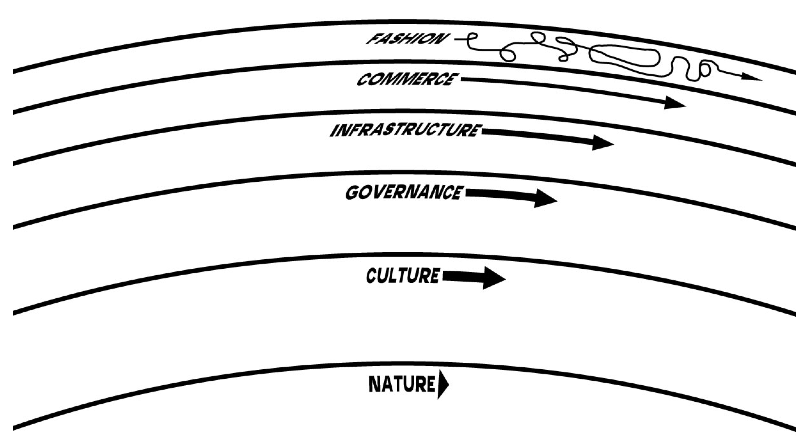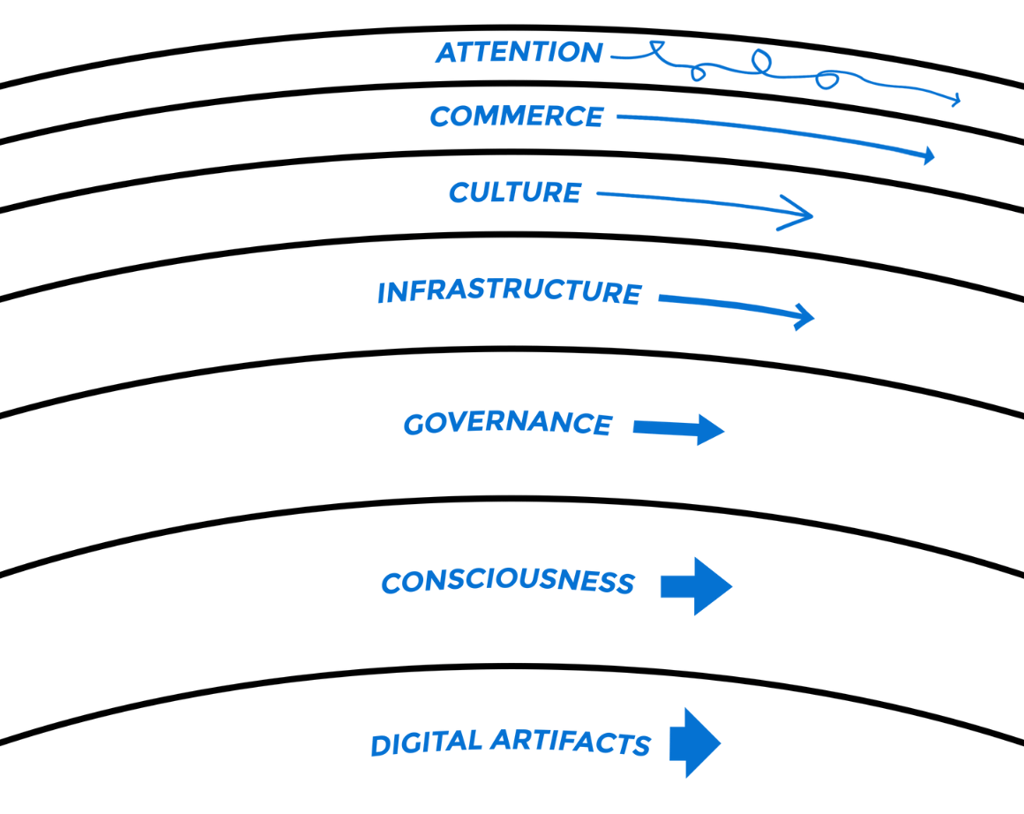The Digital Noosphere
This article reimagines Stewart Brand’s Pace Layers--a framework for understanding how society balances fast innovation with slow stability--within the context of the digital age. It introduces Digital Pace Layers, aligning each layer with aspects of the emerging noosphere, a conceptual digital “mind” built from human knowledge, culture, and data.
Shiftshapr
3/11/20257 min read
At the base of the Digital Pace Layers lie the Digital Artifacts, which interconnect to form the Universal Content Graph—a semantic network that maps the entire digital noosphere. This graph is more than just a repository of data; it is the foundation for a transformative knowledge economy:
Enduring Value: Immutable records provide a permanent, verifiable basis for digital interactions.
Connectivity: Bridges, metadata, and conceptual artifacts ensure that every piece of information is meaningfully linked.
Cultural Richness: Cultural artifacts and digital assets preserve and celebrate our collective heritage.
New Economic Frontiers: By creating a comprehensive, interconnected digital landscape, the Universal Content Graph will unleash enormous knowledge work. This emerging wave of digital labor—including content curation, asset management, context building, and more—could not only compensate for jobs lost to AI-driven automation but also establish a vibrant, enduring knowledge economy.
The Overweb: A Practical Realization of the Digital Noosphere
Inspired by The Metaweb: The Next Level of the Internet and our Digital Pace Layers, the Overweb is a safe, decentralized, and accountable digital environment that operates above the webpage. It seamlessly integrates bridging and the Universal Content Graph to create a comprehensive context map, enabling individuals to work, learn, and play in a connected digital landscape. By linking immutable digital artifacts, cultural assets, and governance records, the Overweb lays the foundation for a vibrant knowledge economy—one that fosters creative collaboration and offers a pragmatic solution to challenges posed by AI-driven automation.
Key aspects of the Overweb include:
Bridging: Connecting disparate digital artifacts, assets, and cultural information to form a continuous, evolving context.
Universal Context Map: Serving as a comprehensive guide that locates every piece of information within a meaningful digital space, it helps users navigate and contribute to the collective knowledge.
Economic Opportunity: By creating an environment where digital artifacts and context have intrinsic value, the Overweb establishes the basis for a new knowledge economy—potentially generating vast opportunities for knowledge work and offsetting job losses from AI-driven automation.
In essence, the Overweb is not merely the next evolution of the internet—it is a transformative platform where responsible tech, human creativity, and rigorous oversight converge, offering immense opportunities alongside a realistic framework for addressing the challenges of our digital age. By harnessing principles like bridging and the Universal Content Graph, the Overweb establishes the foundation for a robust knowledge economy, empowering individuals to create, share, and derive value from digital artifacts and contextual connections. The Presence browser is the first application built for the Overweb, bringing these ideas to life. Experience this groundbreaking interface by trying out the prototype at presencebrowser.com—just click the bouncing icon in the lower right of the window.
Conclusion
Just as Brand’s original Pace Layers offered a roadmap for resilient civilizations, the Digital Pace Layers—reimagined as a digital mirror of our collective noosphere—provide a blueprint for a robust, ethical, and pragmatic digital future. By integrating the connectivity and placement of information with both traditional and emerging governance, infrastructure, and cultural systems, we can build an internet that is innovative, stable, and deeply human—complete with all its positive, negative, and neutral aspects.
The Universal Content Graph, built on immutable digital artifacts and interconnected by bridges, will serve as the foundation for a knowledge economy that creates new jobs and opportunities. Through the Overweb, we envision a practical, safe, and decentralized digital environment that empowers individuals to work, create, and play in the noosphere—paving the way for a balanced and responsible AI-driven era.
The Digital Noosphere
Bridging Data, Culture, and Governance
MAR 11, 2025
Pace layers provide a multi-leveled framework for understanding resilience, innovation, and adaptation within complex systems. Stewart Brand originally proposed this concept to explain how civilizations maintain their health and stability through the interplay of fast-moving and slow-changing components. As Brand explained, “Fast learns, slow remembers. Fast proposes, slow disposes. Fast is discontinuous, slow is continuous.” This interplay ensures that societies evolve while retaining their long-term stability.
In today’s digital age, ideas and data flow at speeds unimaginable a few decades ago. To grasp this rapid evolution, we need an updated framework—the Digital Pace Layers—that not only organizes digital systems but also mirrors our collective human thought, or the noosphere.
What Is the Noosphere?
Imagine the noosphere as the world’s largest, most interconnected library—a living network that holds every thought, idea, and piece of knowledge ever shared by humans. It’s like a giant, digital mind where all information finds its place and connects with other ideas to form a vast tapestry of collective wisdom.
In this context, the noosphere is more than just data—it’s the placement and connectivity of information. Every piece of knowledge has a “home” and a network of connections that gives it meaning. The digital noosphere includes elements such as:
Ordinals: Permanent inscriptions on blockchains that securely record data.
Metadata and Proxies: Contextual clues that help us understand, verify, and locate information.
Governance Records: Immutable logs of decisions and rules that structure our digital society.
Cultural Artifacts: Digital records of culturally significant information—stories, traditions, and practices that define who we are.
Digital Assets: Multimodal treasures (images, videos, music, etc.) with intrinsic value based on scarcity.
Bridges: Connectors that link different pieces of data, ideas, and assets—much like hyperlinks tie together various parts of the internet.
Conceptual Artifacts: Representations of abstract ideas that capture the essence of our shared thought.
Meta-Domains: Virtual “places” in the digital noosphere defined relative to physical locations, communities, or themes, acting as hubs for concentrated knowledge.
Together, these elements form the backbone of the digital noosphere—a structured, dynamic environment where connectivity gives every piece of information meaning.
Revisiting the Original Pace Layers


Brand’s framework originally featured six layers representing different speeds and functions within societal systems—from the quickest (Fashion/Art) to the slowest (Nature). For example:
Fashion/Art: Constantly innovates and experiments.
Commerce: Rapidly monetizes new trends.
Infrastructure: Builds the foundational systems for stability.
Governance: Establishes rules and ethical frameworks.
Culture: Develops and preserves collective identity and norms.
Nature: Changes at the slowest pace, providing long-term constraints.
Just as in a natural ecosystem—where leaves change in a year, tree crowns evolve over several years, and the entire forest transforms over centuries—the fast layers address immediate challenges while the slow layers preserve continuity and resilience.
Why the Digital World Needs a New Framework
The digital era has transformed our world:
Attention shifts in real time, driven by viral content and algorithmic feeds.
Commerce now operates at the speed of digital transactions and token economies.
Culture is continually redefined through global trends, memes, and digital narratives.
Infrastructure spans both centralized data centers (like those powering Wikipedia or major corporations) and emerging decentralized systems (such as blockchain networks).
Governance now encompasses traditional regulations, corporate policies, and innovative digital oversight, ensuring ethical and effective management of digital interactions.
Consciousness, in the digital sense, captures our collective awareness—but not all of it is positive. Along with uplifting ethical standards and shared values, it also includes more ambivalent or even toxic phenomena (like egregores, viral misinformation, and echo chambers) that shape public perception and behavior.
Digital systems are unique because they are governed by code—rules that guarantee verification, authentication, and permanence. This deterministic quality allows us to build environments that are trustworthy and accountable. More importantly, it enables these systems to serve as a digital map of our collective human mind—the noosphere.
The Digital Pace Layers: A Noospheric Perspective


When viewed through the lens of the noosphere, the Digital Pace Layers become a digital mirror of our collective thought, structured as follows:
1. Attention (Fastest Layer)
Description: The real-time flow of focus and engagement.
Noospheric Role: Sparks fresh ideas and rapid trends—similar to bursts of inspiration in our collective mind.
Example: Viral social media posts and real-time analytics.
2. Commerce
Description: The conversion of attention into economic value.
Noospheric Role: Facilitates the exchange and trade of creative ideas and innovations.
Example: E-commerce platforms, token economies, influencer marketing.
3. Culture
Description: The evolution of shared values, norms, and creative expressions.
Noospheric Role: Forms our collective identity and narrative.
Example: Memes, artistic movements, cultural traditions.
4. Infrastructure
Description: The underlying technical systems and networks.
Noospheric Role: Provides the backbone for our digital world, integrating both centralized (cloud data centers, traditional networks) and decentralized (blockchain protocols, peer-to-peer networks) elements.
Example: Internet data centers, blockchain networks, APIs.
5. Governance
Description: The framework of rules, regulations, and oversight.
Noospheric Role: Maintains ethical standards and fairness across digital interactions—encompassing everything from government regulations and corporate governance to innovative DAO models.
Example: Legal regulations, corporate policies, DAO governance structures.
6. Consciousness
Description: The layer of shared awareness and collective thought that both inspires and challenges us.
Noospheric Role: This layer reflects our collective “mind,” capturing not only our highest ethical aspirations (like privacy rights and sustainability) but also the less ideal aspects—such as toxic groupthink, egregores (collective thought forms that can be harmful), and the complex dynamics of digital hype and misinformation.
Example: Online communities, viral trends, and the interplay between constructive ethical debates and the darker side of collective sentiment.
7. Digital Artifacts (Terra Firma)
Description: The immutable, enduring records that serve as the foundation of all layers.
Noospheric Role: They form the building blocks of our digital memory and cultural heritage, ensuring every idea is recorded, connected, and preserved.
Components Include:
Ordinals: Permanent blockchain inscriptions on Bitcoin and other proof of Work chains like Doge.
Metadata and Proxies: Contextual clues that help verify and locate data.
Governance Records: Immutable logs of decisions and rules.
Cultural Artifacts: Digitally preserved cultural treasures.
Digital Assets: Multimodal creations (images, videos, music) with intrinsic value.
Bridges: Connectors linking disparate pieces of information and assets.
Conceptual Artifacts: Visual representations of abstract ideas.
Meta-Domains: Virtual hubs defined by themes, communities, or geographic analogs.
Digital Artifacts, the Universal Content Graph, and Economic Opportunity
Contribute | Build | Participate
Join us to shape the future of the web.
Connect
© 2025. The Meta-Layer Initiative. All rights reserved.
Ecosystem
Bridgit DAO
Presence AI
Partners
Learn
About
What is a Meta-Layer
Meta-Layer Infra SIG
Join Us
Onchain
Digital Badge
FAQ
Glossary
Roadmap
Blog
